Forces, Space, and Radioactivity
2.1 : Distance, Speed, and Acceleration
Scalar - A quantity that only has magnitude.
One such example is distance. Distance is the length of the path between the starting and ending point.
If a person goes in a circular path, their distance will be 2*pi*r.
Another example is speed. Speed is the measure of how much distance is covered in a given amount of time.
speed = distance/time
Its S.I. units are m/s. Scalar quantities can only be positive values.
Dividing a scalar quantity by a scalar quantity results in a scalar quantity.
Vector - A quantity that has both magnitude and direction.
One such example is displacement. Displacement is the shortest distance from the starting and ending point.
If a person goes in a circular path, their displacement will be 0 (starting and ending point are in the same place).
Another example is velocity. Velocity is the measure of how much displacement is covered in a given amount of time.
velocity = displacement/time
Its S.I units are also m/s. Vector quantities can be both positive and negative values. The sign indicates direction.
Dividing a vector quantity by a scalar quantity, or a vector quantity by a vector quantity results in a vector quantity.
Acceleration - The change in velocity over time. It is a vector quantity. Its S.I. units are m/s².
(finalvelocity-initialvelocity)/time
MOTION GRAPHS
Distance - Time Graphs - Graphed with time as the x-axis and distance as the y-axis.
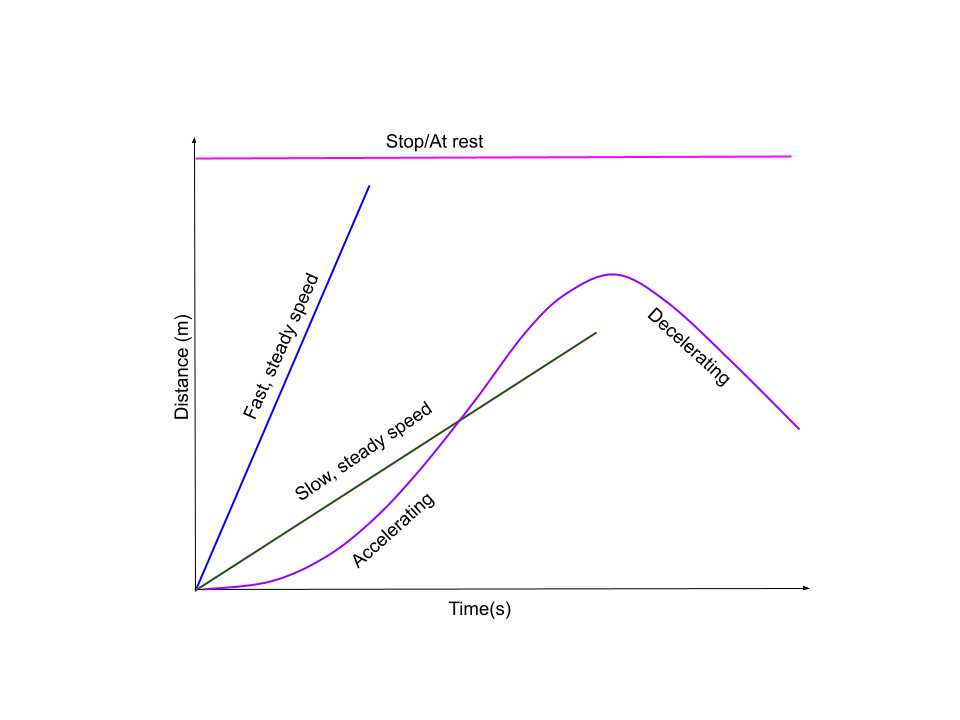
Some important conclusions:
The slope of a distance-time graph represents velocity.
If the line is a curve, the body is accelerating.
Normally, in terms of sign convention, positive means right and negative means left.
If the graph is moving away from the x-axis in the positive direction (has a positive slope), it is moving away from the starting point and forward. If it does so in the negative direction (has a negative slope), it is moving away from the starting point and backward.
If the graph is moving toward the x-axis, it is returning back to the starting point.
Velocity-Time Graphs - Graphed with time as the x-axis, and velocity as the y-axis.
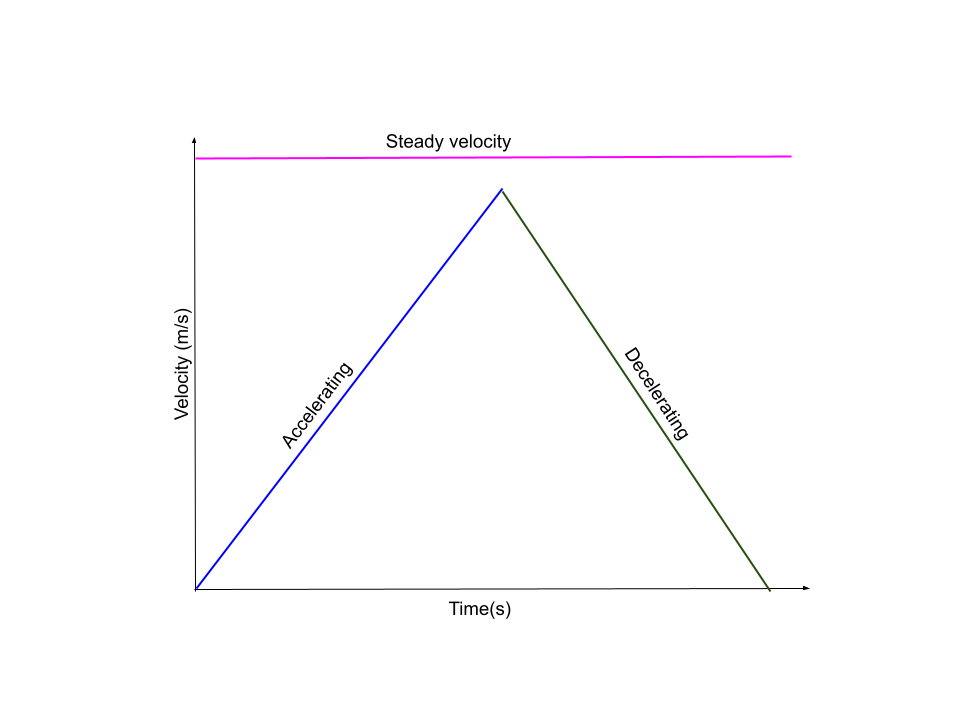 Some important conclusions:
Some important conclusions:
The slope of velocity-time graph represents acceleration.
The area under a velocity-time graph represents displacement.
A change in direction is signified by the graph crossing the x-axis.
If a curve is present on a velocity-time graph, it means that the body is non-uniformly accelerating.
QUESTION: Find the following for each segment of the graph provided below: (i)describe what is happening, (ii) displacement, (iii) acceleration
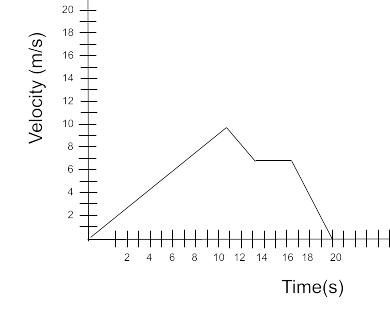
Answer:
The graph can be split into four regions:
SEGMENT 1:
(i) The body is accelerating forward. It starts from rest and and then reaches a speed of 10 m/s in 10 seconds.
(ii) Area of triangle = 1/2*base*height = 1/2×10×10 = 50 m. The distance covered by the body is 50m.
(iii) Acceleration = (10 m/s - 0 m/s)/10s = 1 m/s². The acceleration of the body is 1 m/s².
SEGMENT 2:
(i) The body is decelerating. It starts from 10 m/s and and then reaches a speed of 7 m/s in 3 seconds.
(ii) Area of triangle = 1/2*base*height = 1/2×3×3 = 4.5 m. The distance covered by the body is 4.5 m.
(iii) Acceleration = (10 m/s - 7 m/s)/3s = 1 m/s². The acceleration of the body is 1 m/s².
SEGMENT 3:
(i) The body is travelling at a steady velocity of 7 m/s for 4 seconds.
(ii) Area of rectangle = length*width= 7×4 = 28 m. The distance covered by the body is 4.5 m.
(iii) Acceleration is 0 m/s².
SEGMENT 4:
(i) The body is decelerating, reaching back to the origin. It starts from 7 m/s and and then reaches a speed of 0 m/s in 3 seconds.
(ii) Area of triangle = 1/2*base*height = 1/2×7×3 = 10.5 m. The distance covered by the body is 10.5 m.
(iii) Acceleration = (7 m/s - 0 m/s)/3s = 2.33 m/s². The acceleration of the body is 2.33 m/s².
Calculating the value of a curve
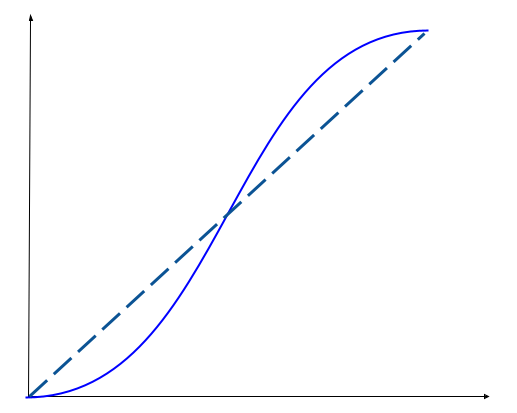 We discussed before that some graphs (like a velocity-time graph) can have curves.
We discussed before that some graphs (like a velocity-time graph) can have curves.
Some questions will require you to provide an average value for the curve. In order to do this without using advanced mathematics, you can simply treat it like a straight line. Make a best fit line that touches the first and last point. Use these two points to find the slope of the curve!
Road Safety
When a car has to stop, the stopping distance is comprised of two types of distances, the thinking distance and braking distance.
The thinking distance is the distance covered by the car while the driver comprehends the situation / reacts to it. During this time, there is no change in speed as the driver has not hit the brakes yet.
Factors affecting the thinking distance include speed and the state of the driver: presence of distractions when driving, alcohol usage, driver’s visibility on the road, etc.
The braking distance is the distance covered by the car from when the driver hits the brakes and the car stops.
Factors affecting the breaking distance include speed and the state of the tires and road.
A faster car has a larger thinking and braking distance.
In a velocity-time graph, the thinking distance is represented by steady velocity while the braking distance is represented by a deceleration till it reaches the x-axis/origin.
Safety features in cars
In order to make driving safer for drivers and passengers, cars have several safety features like air bags, crumple zones (present at the front of the car, so that when a car crashes, the crumple zone takes the impact first) , and safety belts.
The logic that these features follow can be represented by Newton’s second law:
F = m*a = m(final velocity - initial velocity/t)
F represents force, m represents mass, and a represents acceleration. This formula shows the inverse relation between force and time. An increase in the amount of time minimizes the impact of the force applied on the car.
2.2 : Newton’s Laws
IMPORTANT NOTE: Mass and weight are two different things.
Mass (m) : Mass is the amount of matter in the object. Its S.I. units are kilograms (kg).
Weight (w) : Weight is the amount of force of gravity acting on the object. Its S.I. units are Newtons (N).
The difference between mass and weight is that mass is independent. It is the same everywhere. On the other hand, weight is dependent on the force of gravity. This can change based on where you are (in terms of outside Earth, eg. the values of gravity on Earth and the moon are different, hence the values of weight on the moon would be different).
w = m*g
g represents the acceleration due to gravity or the gravitational field strength. Its S.I. units are N/kg. The value of gravity on Earth is approximately 10 N/kg.
QUESTION: When is one considered to be weightless?
Answer: To be weightless, the value of weight must be 0 N. Weight is the product of mass and the gravitational field strength. As already established, mass is a constant value that cannot be changed. Hence, the gravitational field strength would have to be 0 N/kg. This can happen if the body is removed from the Earth’s gravitational field (as you travel away from the Earth’s center, the value of g gets smaller).
The moon’s g (as compared to Earth’s value of g) is g/6.
NEWTON’S LAWS OF MOTION
Newton’s First Law / Law of Inertia
Inertia - Inertia is an inherent property of an object that resists motion.
In other words, if an object is in motion, for example, it would be harder to stop it as compared to allowing it to move as it was before.
The inertia of an object is directly dependent on the object’s mass.
Its S.I. units are kg.
Newton’s First Law - An object will stay in motion/ at rest until an external force is applied to it.
There are two types of net forces: balanced and unbalanced forces.
Balanced forces is when the net force is 0 N. This means that all of the forces acting on the body cancels out. In this case, the motion is unaffected.
Unbalanced forces is when the net force is not 0 N, which affects motion.
Some important force-pairs to remember include:
Weight and Normal Force : When a body is on a surface and the force of gravity (weight) pulls something down, the normal force pushes the body back up. They are equal in magnitude, hence the body doesn’t fly up or sink into the ground.
Weight and Upthrust : Similar as above, but in water.
Newton’s Second Law
A force always causes an acceleration. In the case of unbalanced forces, the resultant force causes the object to accelerate in the direction of the larger force.
Unbalanced forces can cause a change in direction, acceleration, or deceleration.
The relationship provided by the second law states: F = m*a
Terminal Speed : When the resisting (drag) and applied forces (thrust/weight) are equal.
The terminal speed of a body is usually applicable when a resisting force (like drag) is considered in air or water. Normally, an object accelerates or deaccelerates because the drag force and the force applied (usually thrust or weight) is not equal. However, when both these forces are equal, the object reaches its terminal speed.
Terminal speed is also applicable horizontally, for example, when a car is accelerating and the air resistance and frictional force provides a resistance force that equals the thrust force.
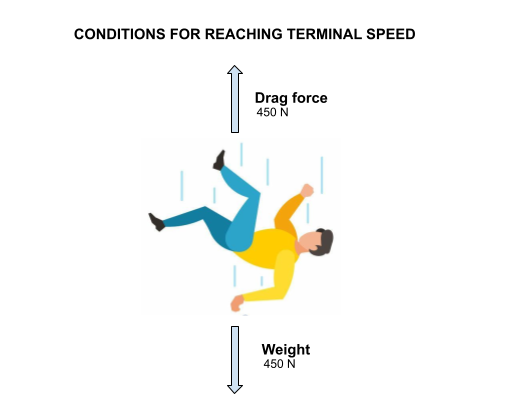 Velocity - Time Graph for Terminal Speed
Velocity - Time Graph for Terminal Speed
Let’s take a scenario where a person is jumping of a plane. This is what the graph would look like (downward is taken as the positive direction) :

Segment 1: The person is falling. The weight is greater than the drag force because the parachute hasn’t opened yet, causing the person to accelerate downward.
Segment 2: The drag (air resistance) and weight force are equal, hence the object’s terminal speed is reached.
Segment 3: The parachute is opened, causing the air resistance to be greater than the gravitational force. The body is decelerating.
Segment 4: A much lower terminal speed is reached.
Segment 5: The sky diver hits the ground.
The drag force is dependent on the surface area of an object. For example, if a coin and a brick were dropped, the coin would reach first because it has less surface area, hence less air resistance is exerted on it.
Newton’s Third Law
Newton’s Third Law - Every force has an equal and opposite force.
Some examples of this law:
Walking: When you walk, your foot pushes backward against the ground. In response, the ground pushes your foot forward with an equal and opposite force, propelling you forward.
Rocket Propulsion: A rocket expels gas out o
f its engines at high speed (action), and the rocket is pushed in the opposite direction (reaction), propelling it forward.
Recoil of a Gun: When a bullet is fired from a gun, the bullet moves forward (action), and the gun recoils backward (reaction) with equal force.
2.3 : Work and Energy
Work (W) : Done when a force acts on an object, causing it to move a certain distance.
Whenever work is done, the total energy in the system remains constant throughout.
Its S.I. units are joules (J).
Work is represented by : W = F*d
Gravitational Potential Energy - An object has gravitational potential energy when it is elevated from the ground to a certain height.
GPE = m*g*change in height
As can be seen from the formula, GPE primarily depends on the mass of an object and its height from the ground.
Kinetic Energy - An object has kinetic energy when it is in motion.
KE = 1/2*m*(change in velocity)²
As can be seen from the formula, KE primarily depends on the mass of an object and the object’s velocity.
Forces acting on a spring
Elastic potential energy - An object has elastic potential energy when its shape is changed (eg. through stretching, compressing)
Hooke’s Law: The force needed to extend or compress a spring by some distance is proportional to that distance.
F = -kx
k represents the spring constant. This is unique to each spring and is a measure of its stiffness.
x stands for displacement by the spring.
the negative sign represents that the spring is moving in the opposite direction of which the force was applied
Force-Extension Graph

Here, ‘e’ represents extension, which is the same as x in the formula. As can be seen by the formula, F and x have a directly proportional relationship, which is why the line is linear.
However, once the spring reaches its elastic limit, then it snaps, causing it to undergo plastic deformation if more force is added. As it has snapped, the line levels.
Work can be found by finding the area under the graph that follows Hooke’s law.
Energy Efficiency
Current vehicles do not use energy efficiently, because in order to do work, cars must first convert chemical to mechanical energy. Engines’ low conversion rate causes most of the energy to get released as heat, making it non-useful.
Friction caused by the surface also causes mechanical friction, causing abrasion to the tires and further energy being released as heat.
Air resistance/ drag force decreases the amount of force that actually goes into pushing the car forward.
Engines - Engines that can carry more fuel are more powerful, however they are more expensive, less energy efficient, and harmful for the environment.
Aerodynamics - Vehicles have been designed to have a slimmer front/ streamlined so that air passes more easily over them, reducing drag.
Air deflectors - Can be installed on vehicles. These help in moving the air around the car.
Traffic lights - Vehicles’ engines often automatically turn off when coming to a stop at traffic lights. Drivers are then required to start the engine again when the accelerator is pressed. This however, causes a significant energy loss due to Newton’s first law (it takes more energy to start a car once it has stopped than to keep a car moving). This energy loss due to inertia is called inertial energy expenditure.
Rolling Resistance / Rolling friction - a measure of the force required to push a car’s tires forward.
Influenced by factors like:
friction between wheels and the road
friction between wheels and axles
2.4 : Further Motion Concepts
Momentum (p) - When a moving object is in motion, momentum is the object’s tendency to stay in motion.
Its S.I. units are kg m/s.
Momentum is defined by : p = m*v
Upon combining momentum and Newton’s second law, we can also get : F = changeinmomentum/t
Conservation of momentum - states that in a closed system where no external forces act, the total momentum is conserved.
m1vi = m1vf
QUESTION : A car with a weight of 300 N is moving with a momentum of 40 m/s. A truck in the opposite direction has a mass of 100 kg and is moving with a speed of 20 m/s. Upon colliding, the truck’s speed is 10 m/s. What would the speed of the car?
Answer:
Well, to start, you might have noticed that we are given the weight of the car instead of the mass. So the first thing we need to do is change that!
W = mg
300 N = m * 10
30 kg = m
Now, lets set up the conservation of momentum equation.
m1vi + m2vi= m1vf + m2vf
(30×40) - (100×20) = (30*v) + (100×10)
1200 - 2000 = 30*v + 1000
-800 = 30v
-26.67 m/s = v
Hence, the speed of the car is -26.67 m/s. The negative sign indicates that the car is moving left after the collision.
Elastic and Non-elastic Collisions
During elastic collisions, the kinetic energy is conserved. In these cases, the equation looks like:
1/2mvi² = 1/2mvf²
During inelastic collisions, the kinetic energy is not conserved. This does not necessarily mean a loss of energy, but rather a loss of kinetic energy. The leftover energy is converted to other types of energy like potential or thermal.
Moment/Torque
A moment is the turning force around a pivot point. It is defined by : M = F*d
Its S.I units are Newton meters (Nm).
Here ‘d’ is the distance from the pivot to where the distance where the force is acting.
When an object is not rotating around a body, it means that the rotational forces/moments are balanced. In other words: sum of clockwise moments = sum of anti-clockwise moments.
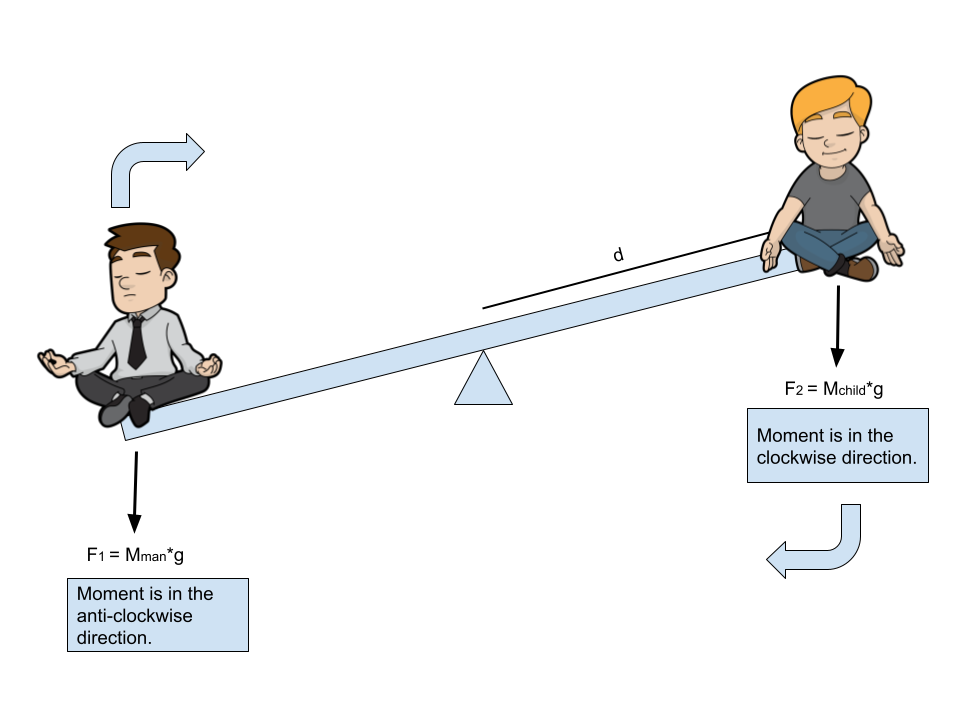
In order for this seesaw to be balanced, T1 = T2 or Mman*g*d = Mchild*g*d.
REAL-LIFE EXAMPLE: Cranes use this philosophy to ensure that when the horizontal arm is being used, the whole crane doesn’t fall over.
2.5 : Stars and Planets
Some foundational information:
The sun is a star, and hence the nearest star in the solar system.
A planet’s orbital time around the sun is directly proportional to how far away it is from the sun.
The planets go around the sun in elliptical orbits.
Pluto is classified as a dwarf planet because it has a highly elliptical orbit that collides with the orbit of Neptune.
Mercury and Venus are the only two planets in our solar system that have no moons.
The first four planets (Mercury, Venus, Earth, and Mars) are rocky planets.
The last four planets (Jupiter, Saturn, Uranus, and Neptune) are gas giants/ gaseous planets.
Comets are balls of rock and ice that orbit the sun. When they come really close to the sun, melts this ice forming an ice tail.
Asteroids are large rocks that are found between Mars and Jupiter in a belt known as the Asteroid Belt.
Scientists theorize that this high density of asteroids is present in this area because Jupiter’s high gravitational force was too strong for the formation of other planets.
In fact, many small dwarf planets can be found in these belts, like Ceres.
The birth of a solar system occurs in a few steps:
A mainly hydrogen-concentrated gas condenses due to gravitational forces. This causes an increase in temperature and the spinning of this dust cloud.
This eventually forms a protostar (initial stage of a star’s life) at the center of the cloud.
Eventually, nuclear fusion (fusion of atoms) occurs, causing the birth of a star.
The rest of the gas and dust eventually forms planets that orbit around the sun.
Due to the enormity of our universe, distances within our solar system are measured in AU (Astronomical Unit).
1 AU is the average unit between the sun and our Earth, which is approximately 1.5 × 10^11 m.
A light year is another unit for distance, which uses the speed of light as a distance.
1 light year = 9,460,730,472,580,800 m.
The speed of light is 3 × 10^8 m/s.
Some handy distances:
Earth to… | Distance |
|---|---|
The Moon | 1.3 light seconds |
The Sun | 8.3 light minutes |
Alpha Centauri (closest star system to our solar system) | 4.4 light years |
Hercules Globular (M13) | 25,000 light years |
Andromeda Galaxy (nearest major galaxy) | 2.5 million light years |
Stars produce energy through nuclear fusion, usually by the fusion of hydrogen and/or helium atoms.
Larger mass stars produce more light and heat, but die quickly.
In terms of temperature, contrary to what might be believed, blue stars are bright will red stars are cool/dying.
Star’s life cycle
 Protostar are unstable. When stars enter the main sequence stage (depending on the mass, they’re either and average mass main sequence star or massive main sequence star) gas and radiation forces push outward to stop the star from collapsing onto itself.
Protostar are unstable. When stars enter the main sequence stage (depending on the mass, they’re either and average mass main sequence star or massive main sequence star) gas and radiation forces push outward to stop the star from collapsing onto itself.
Over time, however, these forces become unstable again.
Gravitational forces < Radiation forces → star cools and becomes red; enter either red giant/ supergiant star stage
As stars age, heavier elements like helium fuse, making the star heavier and giving rise to new elements. As this continues, elements like calcium fuse to maintain a star’s life. Nuclear fusion stops when iron is at the core. The star then starts to collapse on itself.
Red supergiant collapse quickly in an explosion called a supernova. Elements heavier than iron are created and sent out, hence causing formation of new stars.
On the other hand, high mass red super giants form either neutron stars or black holes. In the case of neutron stars, the core has already collapsed. If these giants is more than 3 solar masses, then they form black holes.
Black holes are a very dense point in the gravitational plane, that are so high in mass that not even light can pass through.
Hertzsprung-Russel (H-R) Diagram - A graph that represents stars according to their luminosity (y-axis) and temperature (x-axis).
The diagonal in the graph represents the main-sequence stars.
 Source: Brittania.org
Source: Brittania.org
Our observable universe consists of everything that can be observed by Earth’s telescopes and spans across 93 billion light years. And yet, this is only 5% of our whole universe!
2.6 : The Universe
Diffraction grating : A material that, when light passes through it, creates a continuous emission spectrum. Eg. a prism.
A continuous emission spectrum is a spectrum that contains all wavelengths emitted by a hot, dense light source.
Hot gases do not have a continuous emission spectrum! Instead, they only have a line emission spectrum, which is represented by certain bright lines on a dark background.
Line emission spectrum are specific to each element.
Cool gases absorb certain wavelengths, hence creating a line absorption spectrum. It is represented by black lines in the absorption spectrum.
Fraunhofer Lines
German physicist Joseph van Fraunhofer (1787-1826) developed the spectroscope, which had a diffraction grating. He later found that the spectroscope had some black lines, which is called Fraunhofer Lines (as discussed earlier, this is a line absorption spectrum).
Scientists compared the line absorption spectrum of known elements against a certain line absorption spectrum (eg. a star’s gases) to deduce what elements said spectrum contains.
Cosmological red shift of galaxies
Doppler Shift is when the movement of an object causes either the compression or stretching of waves. This is best observed when a vehicle, like an ambulance’s sound, gets louder or softer as it moves closer or farther away from a person.
When two objects are moving closer together, it is called blue shift.
When two objects are moving farther away from one another, it is called red shift.
Edwin Hubble first discovered the red shift when he realized that the absorption dark lines got wider. This indicated that the galaxies are moving away from one another.
He stated that there was a direct relationship between the red shift and the distance between two galaxies.

This graph shows Hubble’s Law, which states how that if the distance between two galaxies doubles, then the recessional velocity (the velocity at which two galaxies are moving away from each other) also doubles.
The gradient/slope of the graph gives Hubble’s constant.
Calculating 1/H gives the age of the age of the universe (approx. 13.8 billion years).
CMB (Cosmic Microwave Background) Radiation
George Lemaitre proposed that the universe started as a result of the Big Bang in 1927.
In 1948, it was suggested that if the Big Bang theory did occur, there would have to be some remnant, or specifically, some radiation that was left over from the start of the universe.
This radiation was discovered in 1964 by Arno Penzias and Robert Wilson accidentally when they found a static buzzing sound by their radio antenna that couldn’t be attributed to any source.
2.7 : Types of Radiation
Atomic Structure
Atoms contain three sub-atomic particles, the protons, the neutrons, and the electrons.
The protons and neutrons are present in the nucleus and the electrons orbit around the nucleus in orbits/energy levels.
Protons have a relative mass of 1 and a charge of +1.
Electrons have a relative mass of 0 and a charge of -1.
Neutrons have a relative mass of 1 and a charge of 0.
The number of electrons and protons are equal in an atom.
If one or more electrons is lost / protons>electrons, it becomes a positively-charged ion.
If one or more electrons is gained / protons<electrons, it becomes a negatively-charged ion.
The atomic number is the number of protons in an atom. It is denoted by Z.
The mass number is the sum of protons and neutrons in an atom. It is denoted by A.
A isotope is an atom with the same number of protons but different number of neutrons. Eg. Deuterium (Protons: 1, Neutrons: 2), Tritium (Protons: 1, Neutrons: 3).
Radiation
There are three types of ionizing radiation (radiation removes electrons from atoms): alpha, beta, and gamma.
Alpha radiation: An alpha particle consists of 2 protons, 2 neutrons, and 0 electrons.
Beta radiation: Consists of highly energized electrons released from the nucleus, where these electrons are formed from the splitting of a neutron into a proton and an electron.
Gamma radiation: Waves with short wavelengths of high frequency.
Nuclear Waste Disposal
Category | Examples | Disposal |
|---|---|---|
Low | Polluted equipment | Clay-lined landfills |
Intermediate | Components from nuclear reactors | Mixed with concrete and put in a stainless steel drum |
High | Nuclear fuel and chemicals | Stored underwater (20 years), then put in casks for air circulation. |
High category nuclear waste becomes intermediate after air circulation.
Sources of natural radiation include cosmic rays, rocks and soil (emit radioactive radon gas) and plants (absorb from rock and soil and pass it up the food chain).
Artificial radiation includes X-rays (usually for medical scans), Nuclear missiles (rocket industry and nuclear warfare) and nuclear power stations. Artificial radiation is responsible for nearly 15% of background radiation.
The random nature of radioactive decay
The nuclei of radioactive atoms are quite unstable. They soon start to break down, which is called radioactive decay.
The decay of radioactive atoms are random and hard to predict.
The amount of time it takes for half of the nucleus of an atom to disintegrate is called half-life. Eg. Carbon-14 has a half-life of 5,370 years.
The count rate is amount of radiation reaching a detector in a given time.

Properties of radiation
Radiation becomes weaker as it covers more distance.
The thicker a substance is, the more radiation is absorbed.
Alpha radiation can be stopped easily, and can be absorbed by a human hand.
Beta radiation can go through thin substances like air and paper, but can be absorbed by aluminum foil.
Gamma radiation can go through many things, and can only be stopped by a thick slab of concrete.
Nuclear Equations
During alpha decay, the mass number decreases by 4 and the atomic number decreases by 2.
During beta decay, a neutron splits into a proton and an electron. Hence, the mass number stays the same. The atomic number increases by 1.
Carbon-14 into Nitrogen-14

2.8 : Half-Life
Decaying occurs in halves. If the parent atom starts with 16 atoms. After 1-half life, this reduced to 8 atoms. After 2-half lives, this is reduced to 4 atoms.
Graph for pattern of atom decay

The activity of radioactive isotope is measured in becquerel (Bq). 1 Bq = 1 decay per second. This is also demonstrated counts per second, or a ‘click’ on a Geiger counter (measures radiation).
Some important half-lives to remember!
Isotope Name | Half-Life |
|---|---|
Thorium-32 | 14,000 million years |
Uranium-235 | 704 million years |
Plutonium-239 | 24,110 years |
Carbon-14 | 5,730 years |
Caesium-137 | 30 years |
Cobalt-60 | 5.27 years |
Polonium-260 | 138 days |
Techentium-99m | 6 hours |
Polonium-218 | 3 minutes |
QUESTION: The half-life of a radioactive isotope is 12 years. How long will it take its mass to go from 6g to 0.75g?
Answer:
6g → 3g → 1.5g → 0.75g
This took 3 half-lives. If each half-life is 12 years, then : 12×3 = 36.
It will take 36 years for the mass of the radioactive isotope to decay from 6g to 0.75g.
To find the half-life of an isotope from a graph, divide the largest number in terms of activity on the graph (present on y-axis) by 2. Then find the x-value for this number. This is the half-life.
Uses of radioactivity
Thickness of paper (measured by beta radiation)
Prolonging life span of fruit (done by bombarding gamma particles)
Smoke alarms (alpha particles charge air and stop current exchange in air, stopping smoke alarm)
Blood and fluid tracers (Technetium-99m, a gamma particle, is used for blood tracing)
2.9 : Nuclear Decay and Nuclear Energy
Nuclear Fission - Splitting of a nucleus.
The absorption of slow moving neutrons can cause a chain reaction.
Nuclear fission does not occur in fast-moving electrons.
If an isotope is hit by a neutron, the following happens:
Nucleus splits into two parts called daughter nuclei
Two to three neutrons are released
Some energy is released in the form of K.E.
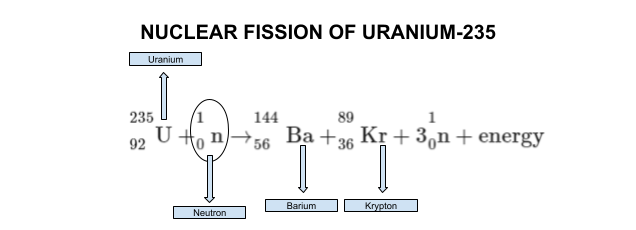
A chain reaction is when neutrons released from the above reaction hit other Uranium-235 atoms, causing the splitting of nuclei.
Nuclear reactors use the heat from nuclear reactions to power them. These do not release C02 in the process. Harmful ionization is trapped by steel and concrete walls to ensure that it doesn’t leak.
Moderator or control rods control the rate of a nuclear reaction in a nuclear reactor by absorbing extra neutrons to ensure only one neutron is hitting the isotope. (More than one would cause a nuclear reaction). Moving these rods up leads to fewer neutrons being absorbed, while moving the rods down leads to more neutrons being absorbed.
Containment buildings are the buildings that surround nuclear reactors. Radioactive materials are contained, and protected from external or restricted use.
Nuclear fusion involves a deuterium (1 proton, 1 neutron) and a tritium (1 proton, 2 neutrons) nucleus fusing. Their same charges causes repulsion called electromagnetic repulsion.
This happens in stars where two hydrogen atoms fuse to make a helium atom, creating energy.
Currently, there is not enough technology to use nuclear fusion as a sustainable energy source.